October 2016
Review
ENG––FRA
Cinema as a country:
The cinematic act as reappropriation of a contested territory
Hotel room.
The sound of the shower is heard.
On the TV, a blonde muscled man opens a van’s side door and starts shooting with a machine-gun.
It was at that exact moment that HE came out of the shower to discover the scene unfold beneath his eyes for the second time, this time on a TV screen.
In fact, it was around 1986 that the blonde muscled man, who turned out to be Chuck Norris, started shooting out of that same van.
2 EXT/DAY – JAFFA – 1980’s
HE stands on the sidewalk surrounded by a few boys his age. They are all waiting for the film shoot to begin.
Suddenly, a van appears and a blonde and muscled man, who turned out to be Chuck Norris, shoots from a machine-gun.
Some twenty years later, in a London hotel room, HE will find himself witnessing the same scene, this time on a TV screen.1

The origin of Recollection (2015) is a drifting gaze that recognizes its childhood hometown in the background of fictional films. The city is Jaffa in Palestine, the gaze that of Kamal Aljafari, and the films are Israeli and American fiction films shot between 1960 and 1990, in which the city of Jaffa serves as a backdrop to the action. The director’s gaze glides on the surface of the screen, wandering in the places he grew up in. This gaze will experience these places twice: once directly, in the past as a child; and a second time through the mediation of fiction, in the present of adulthood. In between these two moments, thirty years have passed, the young boy has grown into a filmmaker, and the city has transformed into an unrecognizable place. In fact, since the 1980s, Jaffa has been (and still is) subjected to multiple waves of demolitions orchestrated by the Tel Aviv municipality. This city, the way it is seen in these films and the way Aljafari knew it, doesn’t exist anymore. All that is left are images pushed to the back of narratives that choose to ignore it. The places are erased and literally rejected to the back of the screen. The resulting image is layered: buried under the Israeli fiction is the reality of the city of Jaffa and its inhabitants. Aljafari seems to detect this latency and crafts a film from these backgrounds where the main characters are digitally erased. Therefore Recollection, through the use of Israeli and American images as its material, in turn erases these fictional narratives from this footage, keeping only the city.
Recollection opens on a short sequence, of about one minute in length that distinguishes itself from the rest of the film in its rhythm, form and music. This sequence takes place before the title appears: it is not part of the diegesis and is instead used to introduce and establish the deployed strategy. Kamal Aljafari is telling us that what interests him in these images are the backgrounds and the place they contain. It is for him a matter of eliminating any element that presents itself as an obstacle. In his press release, he writes: “I removed the Israeli actors simply because they stood in my way – technically speaking”. With the help of digital tools, credits, cars, men, women and children, these protagonists of the Israeli and American films are extracted from the picture and the background is reconstructed to remove all traces of their existence. What is left is empty frames of a city in ruins.

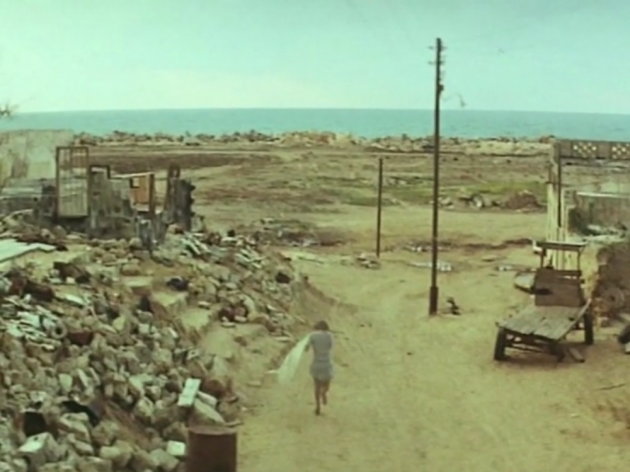
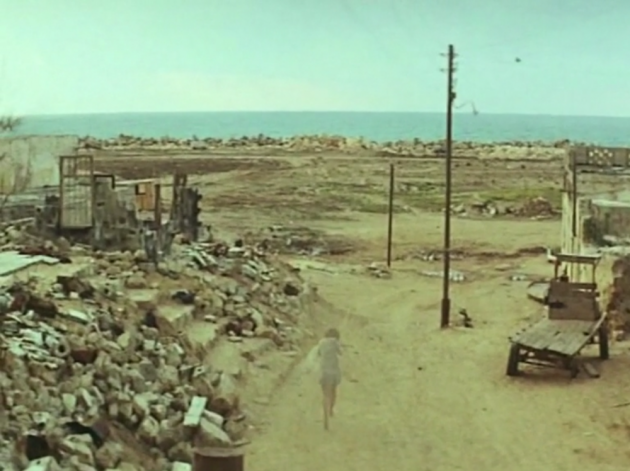
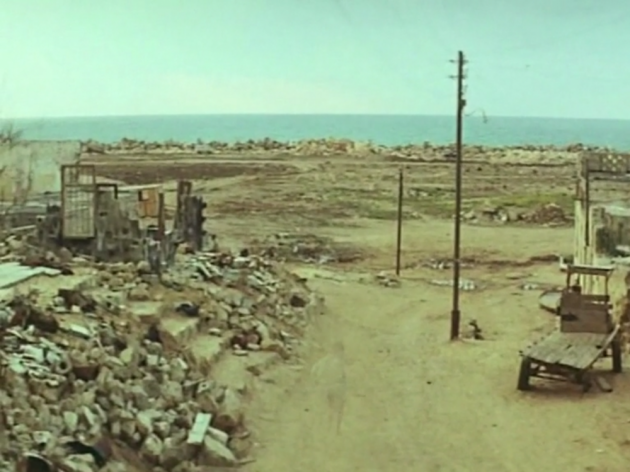
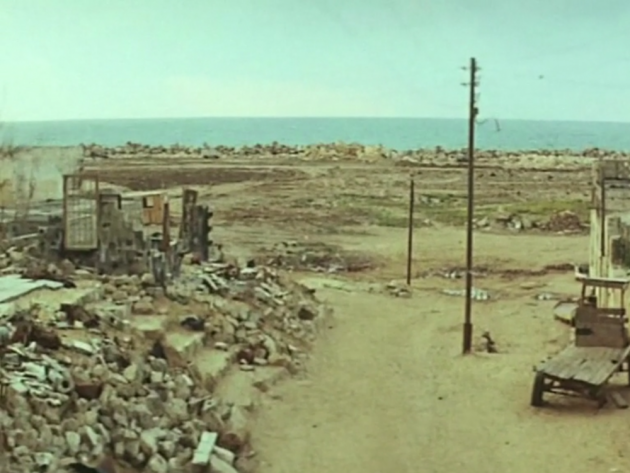
This sequence retraces the origin of the images that will make up the body of the film, insisting on their ‘fabricated’ nature. By intervening on these images, the filmmaker crafts the raw material for the exploration of the city of Jaffa; ‘rushes’ that he will drift from and upon throughout the whole film. It is the image of a past city, the city of childhood submitted to destruction, remodeling and reconstruction that is revealed to the filmmaker. The Israeli and American fictions are accidental containers that conserve and preserve a city whose image was forcibly forgotten. These fictional images become archives, documenting a place as it once was. In an interview with Antoine de Baecque and Thierry Jousse, Jacques Derrida says that the “present prevents representation”2 and that the restitution of a memory in cinema must be done through the apprehension of traces and imprints. When Aljafari re-employs fictional images as archival documents he sees them as traces of a lost city.
The opening sequence attributes to the fictional images of the Israeli and American films the function of documenting the city during the moment of filming. Aljafari rubs out the protagonists in order to have full and unobstructed access to these ‘archives’. But this gesture only reveals an empty place. In fact, all you need to do is delete the characters in the foreground to realize that the frames are deserted. The city is not empty; it was emptied out by the Israeli narratives. To understand furthermore this phenomenon, it would be interesting to examine the nature of the feature films that Recollection is reappropriating. The first selection criterion is obvious: look for films that were shot in Jaffa. From there on, the filmmaker embarked in an exhaustive, years long process of watching and collecting. Since Jaffa is the main backdrop of a genre of Israeli films called ‘bourekas films’, it is these films that will make up the majority of the material that will interest the filmmaker. ‘Bourekas’ are Israeli melodramatic romantic comedies that were popular between 1967 and 1977. They generally tell stories of impossible love affairs between Ashkenazi (European and Eastern European Jews) and Mizrahi (Arab Jews) in Israel3 These films convey very stereotyped representations of both communities. The box-office success of the ‘bourekas’ films is actually due to the fact that these films dream of unity in a strongly divided and stratified society. Curiously enough (but also not so surprising), ‘bourekas’ represent an ‘ethnically diverse’ space in which all Palestinian presence is erased. The Palestinian inhabitants of Jaffa are excluded from the narrative and thus deprived of all representation, finding themselves twice uprooted: in reality, in 1948, as well as in the cinematic fictions of the 1970s. Kamal Aljafari reflects on the reasons that make Jaffa an attractive location to the Israeli film industry:
Why would filmmakers persist in filming Jaffa and not Tel Aviv, their icon of modernity, even in the 70s? […] For them to have shot Tel Aviv would have been to acknowledge the unthinkable of their imaginary: ‘we are new here.’ Film needed Jaffa to make the point that Israelis have a history there, too. But they could only show it as they left it: ruined, neglected, abandoned, destroyed—and with not a word on how or why it came to be that way. Their actors walked down the street and past the dreadful ruins. As if nothing had happened; as if the streets had always looked that way.4
The film shoots build an Israeli cinematic collective memory that affirms the founding premise of Zionism. This premise postulates that the arrival of the Israelis in 1948 was not the occupation of an inhabited territory but their settlement on an empty land.

Aljafari’s film is part of a larger project of his called Cinematic Occupation. Cinematic Occupation was birthed when Aljafari, upon discovering his childhood hometown in fiction films, projected them on a big screen to photograph the background. He made sure to exclude the protagonists from his frames. His lens scans the borders of the images to save as many details as possible (streets, walls, textures, motifs, and also the extras that were accidentally lost in the background). From the long hours spent in the darkness of the screening room, Aljafari produced roughly around 20,000 photographs. The initial plan was to publish them in a book, a sort of a family album that would be capable of re-telling the story of Jaffa through its details. A selection of these photographs was exhibited as post cards at the Radcliffe Gallery at Harvard in 2010 and entitled Not Without Me. They were also shown at the Beirut Art Center in 2015 as part of the collective exhibition Aftercinema. In fact it is during that exhibit that a first cut of Recollection, under the name Untitled 2015, was projected alongside the postcard sized photographs. The postcard format is very expressive in the context of this project because it is a ‘delocalized’ image that carries within it traces of a past locality – an “I was there”. Producing postcards from fictional images of Jaffa is a way of allowing the city to be visited, lived and performed and in this sense, restored. Let’s go back to Derrida’s idea of the trace in cinema that he conceives as the ultimate site of survivance:
The trace is the “that-took-place-there” of the film, what I call survivance. For all of these witnesses are survivors: they lived that and say so. Cinema is the absolute simulacrum of absolute survivance. It recounts to us what we cannot get over, it recounts death to us. By its own spectral miracle, it points out to us what ought not to leave any trace. It is thus doubly trace: trace of the testimony itself, trace of the forgetting, trace of absolute death, trace of the without-trace, trace of the extermination. It is the rescue, by the film, of what remains without salvation, salvation for the without-salvation, the experience of pure survivance that testifies.“5
In trying to seize the traces left by his city in these images, Aljafari erases, crops, re-edits, zooms, freezes, plays backwards and inverses shots. The image becomes a space and a surface to be explored. Aljafari’s imaginary camera seems to be looking for the marks that time has left on things. It stops on a wall, a window, stairs, an empty lot, sand, a façade, then another one, a house, a road. It is obsessed by space. By focusing on the architecture and the form of the city, the imaginary camera generates a discourse where place is the site from which the history of Jaffa is re-written. The place itself will narrate its own story, disturbing official colonial narratives built by the Israeli and American films.
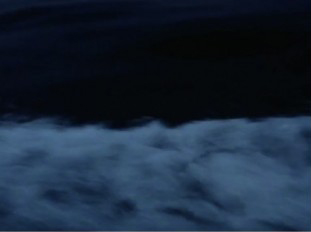

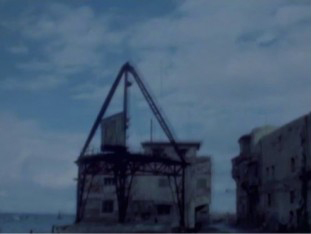

The frame trembles. The camera is subjective, it arrives to Jaffa by sea. The city is empty. The camera-body advances. We hear its footsteps. The city starts to unravel in front of us. We follow the camera-body wandering in a deserted city, lingering on the walls, the buildings, the rooftops and the streets. The camera-body walks. Its footsteps are synchronized to its movements. So are the sounds of the handling of the camera. The sound anchors us in the image and therefore in the place. We are taking part of a real time tour of Jaffa. This walk gives form and movement to the city. This walk maps out Jaffa. A detail emerges: a line on hung laundry. The space is inhabited. Pan to the right. We notice a movement, a body hiding behind a lamppost. The camera-body goes out looking for these dispersed extras. Little by little, the city becomes populated.

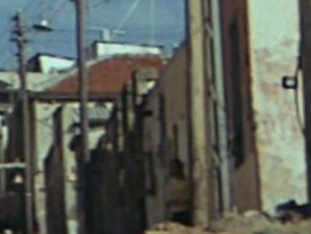
When Kamal Aljafari recognizes the stones of a street corner that he used to lean against as a child—the same corner where his grandfather used to spend his afternoons listening to the radio—in the background of an Israeli fiction film, the filmmaker engages in a process of remembering. Through its act of reappropriation, Recollection implements a strategy of commemoration. The shots on the walls, the buildings, the lots, the windows as well as the faces, the bodies, the movements and the objects are all of equal value. They are all witness of a place that no longer exists. “They were there — where it took place”. They are not revenants simply because they never left Jaffa. Despite the Israelis’ efforts to make them disappear – in reality as well as in fiction – they remain embedded into the multiple strata of fiction. Being at the same time in the past and in the present, they are spatial and temporal hinges that Aljafari takes a hold of to allow Jaffa to narrate itself. Christa Blümlinger writes that “it is not a matter, as in traditional historiography, of ‘official’ facts of a history of events anymore, but of monuments in the sense of something speaking directly, something that wasn’t initially destined to bear witness or talk”6 In fact, in the images that Aljafari re-employs, an ‘official’ history is embedded by the Zionist narrative to legitimize its presence on the territory that it colonizes. In these films, Jaffa doesn’t exist, it has no voice and no representation. Jaffa has nevertheless an accidental image that resides in the back of the screen. This image is a recording and not a representation in the sense that it was not produced to represent a certain place—since all possibilities of representation are confiscated by the Israelis—but captured and recorded in surplus. This image is a monument for “for carrying memory by the simple fact of not being concerned by anything other that its own present”.7 The gaze that lays Recollection on the background is actually an act of listening to the place and its inhabitants’ testimony, restoring to Jaffa the right to its own history.
The end of the film adds a new layer of interpretation for the spectator. A text scrolls upwards in the style of ending credits. Instead of names of actors, technicians and creative positions, the spectator reads stories that would be the captions for the different shots of the film. These stories are very intimate and subjective, naming the inhabitants (who are none other than Aljafari’s family, friends and neighbors) and locations of Jaffa. Written in first person and referring to individuals mostly close to the author, these stories recall the commentaries that could be made during a viewing session of a family photo album. This reference to the family album appears at various other moments in the film. The freeze frames, screenshots and frame-by-frame culminate, towards the end of the film, in an editing of photographs of buildings punctuated by moments of black and a soundtrack that is almost silent. To the spectator, it is as if they are watching a slide show projection of personal photographs taken from a family album. Choosing to simulate the aesthetic of a handheld camera and emphasizing the sounds of the footsteps and the handling of the camera adds to the feeling that the viewed sequences are of a ‘private’ origin. Christa Blümlinger associates the private film documents with amateur and family films, placing their reappropriation as a way to access macrohistory through microhistory, transposing “memory from realm the family towards a socio-cultural space”.8 In its attempt to restitute a collective memory to the inhabitants of Jaffa, Recollection will inverse this equation, creating a family album from fictional images.
Due to the material transformation and disappearance of Jaffa, the images in Recollection are without a reference. They strongly indicate a place without being able to actually refer to it. Within the colonial logic, the destruction of the city of Jaffa moves the conflict from reality to fiction: the image is the contested territory. Recollection is not only a symbolic gesture of reappropriation, but a very concrete way to reclaim a stolen territory, that of the image and cinema.
Kamal Aljafari’s film materializes an act of resistance against the occupying Israeli forces – but also against forgetfulness, erasure and exclusion – that is only possible through cinema. After watching his hometown and his community being subjected to decades of external and internal exile, the filmmaker inverses the power relations and erases, in his turn, the Israelis and their own narratives.
Despite its strong relationship to the specificity of the place, Recollection simultaneously attempts to get rid of this particularity. The filmmaker writes in the film’s press release:
A film about any of the ruined cities: Aleppo, Detroit, Berlin, where one can live now. Let it be any catastrophized place: any place where fiction films were shot, and where the camera ate the place that it shot, alive.
Jaffa is also Aleppo, Detroit, Berlin, Beirut, Damascus, Jerusalem, Cape Town and Kigali. In fact, the director purposely omits the citation of the sources of the re-employed images. One has to read the synopsis or the press release to understand that he is dealing with images taken from Israeli and American films shot in Jaffa between 1960 and 1990. With the exception of the opening sequence, which briefly presents the intention, the film follows the desire to present the city as independent from the fiction that contains it. Jaffa is captured in its banality (buildings, windows, walls, stones, everyday gestures and movements of the Palestinian extras…) in an attempt to show the city in its day-to-day life and not only as the site of a traumatic event. We can read this resistance as a way of liberating Jaffa from the oppression of its own history and therefore as an homage, or even a glimpse of hope to all these other cities that have suffered a similar fate.
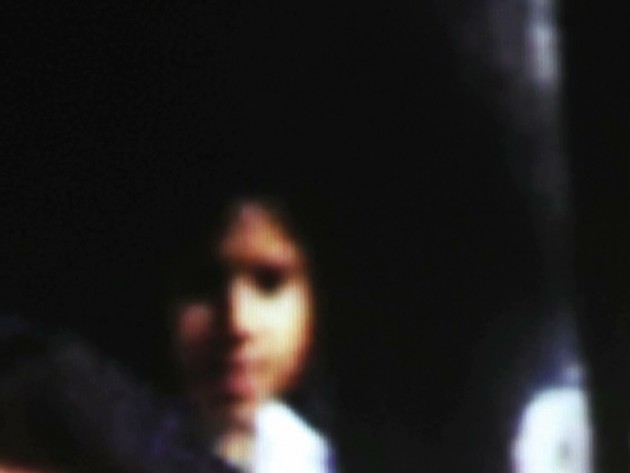
NOTES
1 These two scenes are fictionalized based on a quote that appears in Recollection’s press release that can be found on Kamal Aljafari’s website.
The filmmaker notes: “I was the blue boy’s age when I saw a film crew for the first time. I waited with some other children for the filming to begin. Suddenly a van appeared, and a blonde man opened the van’s side-door and started shooting with a machine-gun. ‘That’s Chuck, Chuck Norris!’ Decades later, visiting London, I emerged from the hotel-room shower to see the blonde man still shooting from a van in Jaffa on the TV.” The film that is referred to in this text is The Delta Force, a film directed by Menahem Golan in 1986, starring Chuck Norris.
The filmmaker notes: “I was the blue boy’s age when I saw a film crew for the first time. I waited with some other children for the filming to begin. Suddenly a van appeared, and a blonde man opened the van’s side-door and started shooting with a machine-gun. ‘That’s Chuck, Chuck Norris!’ Decades later, visiting London, I emerged from the hotel-room shower to see the blonde man still shooting from a van in Jaffa on the TV.” The film that is referred to in this text is The Delta Force, a film directed by Menahem Golan in 1986, starring Chuck Norris.
2 de Baecque, Antoine; Jousse, Thierry; Derrida, Jacques; and Kamuf, Peggy (2015) “Cinema and Its Ghosts: An Interview with Jacques Derrida,” Discourse: Journal for Theoretical Studies in Media and Culture: Vol. 37: Iss. 1, Article 2. p.31.
3 Limbrick, Peter. 2012. « Contested spaces : Kamal Aljafari’s transnational palestinian films ». In Terri Ginsberg et Andrea Mensch (dir.), A Companion to German Cinema. Wiley-Blackwell. p. 237.
4 de Baecque, Antoine; Jousse, Thierry; Derrida, Jacques; and Kamuf, Peggy (2015) “Cinema and Its Ghosts: An Interview with Jacques Derrida,” Discourse: Journal for Theoretical Studies in Media and Culture: Vol. 37: Iss. 1, Article 2. p.31.
4 de Baecque, Antoine; Jousse, Thierry; Derrida, Jacques; and Kamuf, Peggy (2015) “Cinema and Its Ghosts: An Interview with Jacques Derrida,” Discourse: Journal for Theoretical Studies in Media and Culture: Vol. 37: Iss. 1, Article 2. p.31.
5–6–7 Blümlinger, Christa. 2013. Cinéma de seconde main : esthétique du remploi dans l’art du film et des nouveaux médias. Translated from German by Pierre Rusch and Christophe Jouanlanne. Coll. « Collection d’esthétique ». Paris : Klincksieck. p. 186.
FRENCH
1 INT / JOUR – LONDRES – ANNÉES 2000
Chambre d’hôtel.
Le son de la douche se fait entendre.
À la télé, un homme, blond et musclé, décharge une mitraillette à partir d’un camion.
C’est à ce moment là qu’IL sort de la douche pour découvrir la scène se dérouler une deuxième fois sous son regard, cette fois-ci sur un écran.
En effet, c’est vers 1986 que cet homme blond et musclé, Chuck Norris en l’occurrence, a commencé à tirer à partir de ce même camion.
2 EXT / JOUR – JAFFA – ANNÉES 1980
IL se tient au bord d’une rue, entouré de quelques garçons de son âge. Ils attendent le début d’un tournage.
Soudain, un camion apparaît et un homme blond et musclé, Chuck Norris en l’occurrence, décharge une mitraillette.
Une vingtaine d’années plus tard, dans une chambre d’hôtel à Londres, IL va se retrouver témoin de cette même scène, cette fois-ci sur un écran de télévision1.

À l’origine de Recollection (2015) il y a la déambulation d’un regard qui reconnaît sa ville d’enfance dans l’arrière-plan de films de fiction. Cette ville c’est Jaffa en Palestine et le regard, celui de Kamal Aljafari parcourant tous ces films des fictions israéliens et américains tournés entre 1960 et 1990, et dans lesquels la ville de Jaffa sert de décor au récit. Le regard du réalisateur glisse sur la surface de l’écran, errant dans les lieux de son enfance. Ce regard va faire l’expérience de ces lieux à deux reprises : une première fois en direct, dans le passé de l’enfance, et une deuxième fois par la médiation de la fiction, dans le présent de l’âge adulte. Entre ces deux moments : une trentaine d’années s’écoulent, un jeune garçon devient cinéaste et une ville se transforme au point de ne plus se ressembler elle-même. En effet, Jaffa a connu depuis les années 1980 plusieurs vagues de démolitions orchestrés par la municipalité de Tel Aviv. Cette ville, tel qu’on la voit dans ces films de fiction et tel que la connue Aljafari, n’existe plus. Le lieu est effacé et rejeté littéralement vers le fond de l’écran. Jaffa n’est qu’un décor. L’image qui en résulte est une image qui se construit en couches : enterré sous la fiction israélienne, il y a la réalité de la ville de Jaffa et ses habitants. Aljafari semble détecter cette latence et élabore donc un film à partir de ces arrière-plans. Ainsi, Recollection se compose entièrement des images de fiction de ces films israéliens et américains desquels le cinéaste va effacer, à son tour, les personnages principaux pour ne garder que la ville.
Recollection s’ouvre sur une courte séquence, d’une minute environ, qui se démarque du reste du film par son rythme, sa forme et sa musique. Se déroulant avant l’apparition du titre, cette séquence n’appartient pas à la diégèse et sert de mise en place du dispositif employé. Kamal Aljafari nous indique ce qui l’intéresse : l’arrière-plan et le lieu qu’il contient. Il s’agit alors d’écarter tout élément qui se présente comme obstacle. Grâce à des outils numériques, les génériques, les voitures, les hommes, les femmes et les enfants, protagonistes des films israéliens et américains, sont extraits de l’image et le fond est reconstruit pour effacer toute trace de leur existence. Reste des cadres vides sur une ville en ruine.





Cette séquence retrace l’origine des images qui vont constituer le corps du film tout en insistant sur leur nature ‘fabriquée’. De par son intervention sur ces images, le réalisateur se confectionne une matière première pour l’exploration de la ville de Jaffa, un matériau à partir duquel il va dériver tout au long du film. Un espace ayant subit multiples démolitions, remodelages et reconstructions, c’est l’image d’une ville passée, celle de l’enfance, qui apparaît sous les yeux du cinéaste. Ces fictions sont des conteneurs accidentels qui conservent et préservent malgré eux une identité visuelle oubliée de la ville. Ces images deviennent ainsi des archives et la fiction le document d’un lieu tel qu’il n’est plus. Dans un entretien avec Antoine de Baecque et Thierry Jousse, Jacques Derrida affirme que « le présent empêche la représentation » et que la restitution d’une mémoire au cinéma doit passer par la saisie de traces et d’empreintes. En réemployant les images de fiction comme documents, Aljafari les posent comme traces d’une ville disparue.
La séquence d’ouverture assigne à l’image de fiction des films israéliens et américains tournés à Jaffa la fonction de documenter la ville au moment du tournage. Aljafari gomme les protagonistes pour accéder pleinement et sans obstruction à ces ‘archives’. Mais ce geste d’effacement ne fait que révéler un lieu vide. En effet, il suffit de supprimer les personnages au premier plan pour obtenir des cadres déserts. La ville n’est pas vide, elle a été vidée par la fiction.
Une question s’impose : quels sont ces films que Recollection emploi comme matière première? Le premier critère de sélection est évident : des films tournés à Jaffa. De là, le cinéaste s’est embarqué dans un processus de visionnage et de cueillette quasi exhaustif qui va durer plusieurs années. Et comme Jaffa va être le décor principal d’un genre de films israéliens appelé les ‘bourekas films’, ce sont ces films là qui vont constituer la majorité du corpus que retient le cinéaste. Les ‘bourekas’ sont des comédies mélodramatiques israéliennes populaires produits entre les années 1967 et 1977 qui racontent des histoires d’union impossible entre Ashkenazi (juifs en provenance d’Europe et d’Europe de l’est) et Mizrahi (juifs arabes) en Israël 4 . Ces films proposent des représentations très stéréotypées de ces deux communautés et le succès populaire des films ‘bourekas’ proviendrait du fait qu’ils rêvent une union au sein d’une société fortement divisée et stratifiée. Curieusement (mais aussi sans surprise), les ‘bourekas’ représentent un espace ‘ethniquement diversifié’ duquel toute présence palestinienne est effacée. Les habitants palestiniens de Jaffa sont exclus du récit et donc privés de toute représentation et se retrouvent doublement déracinés, dans la réalité en 1948 et dans la fiction dans les années 1970. Kamal Aljafari se questionne dans cette perspective sur les raisons qui poussent les israéliens à tourner à Jaffa :
Why would filmmakers persist in filming Jaffa and not Tel Aviv, their icon of modernity, even in the 70s? […] For them to have shot Tel Aviv would have been to acknowledge the unthinkable of their imaginary: ‘we are new here’. Film needed Jaffa to make the point that Israelis have a history there, too. But they could only show it as they left it: ruined, neglected, abandoned, destroyed-and with not a word on how or why it came to be that way. Their actors walked down the street and past the dreadfuI ruins. As if nothing had happened; as if the streets had always looked that way.
Ces tournages vont ainsi construire un imaginaire cinématographique collectif affirmant la prémisse fondatrice du Sionisme qui postule que l’arrivée des israéliens en 1948 ne serait pas l’occupation d’un territoire déjà habité mais leur installation dans un lieu vide.

Le film d’Aljafari s’inscrit dans un projet plus large intitulé Cinematic Occupation. Ainsi, Cinematic Occupation a commencé lorsque, Aljafari, à la découverte de sa ville d’enfance dans ces fictions, se les projette sur grand écran et se met à photographier l’arrière-plan, prenant soin d’exclure les protagonistes de son cadre. Son objectif scrute les bords des images pour sauver autant de détails possibles (rues, murs, textures, motifs, mais aussi des figurants égarés accidentellement dans le fond). De ses longues heures passées dans l’obscurité de la salle, Aljafari produit environ 20,000 photographies. L’idée de départ était d’en faire un livre, une sorte d’album photo capable de re-narrer l’histoire de Jaffa à partir de ses détails. Une sélection de ces images a été imprimée sous forme de cartes postales. Ce format est intéressant dans le cadre de ce projet puisque c’est une image délocalisée mais qui porte en elle la trace d’une localisation antérieur – « j’ai été là ». Produire des cartes postales à partir des images de fiction de Jaffa est une manière d’ouvrir sur la potentialité de ce lieu à être visité, vécu et pratiqué et donc à être restitué. Revenons sur l’idée de la trace selon Derrida qui va la lier intimement au cinéma pour le concevoir comme le lieu absolu de la survivance :
La trace est le « ça a eu lieu là » du film, la survivance. Car tous ces témoins sont des survivants : ils ont vécu ça et le disent. Le cinéma est le simulacre absolu de la survivance absolue. Il nous raconte ce dont on ne revient pas, il nous raconte la mort. Par son propre miracle spectral, il nous désigne ce qui ne devrait pas laisser de trace. Il est donc deux fois trace : trace du témoignage lui-même, trace de l’oubli, trace de la mort absolue, trace du sans-trace, trace de l’extermination. C’est le sauvetage, par le film, de ce qui reste sans salut, le salut aux sans-salut, l’expérience de la survivance pure qui témoigne.
Dans le but de saisir les traces qu’a laissée sa ville d’enfance dans ces images, le cinéaste procède par effacement, recadrage, remontage, zoom, arrêt sur image, ralenti et même renversement. L’image devient un espace et une surface à explorer. La caméra imaginaire d’Aljafari semble chercher les marques du temps sur la matière. Elle s’arrête sur un mur, une fenêtre, des escaliers, un terrain vague, du sable, une façade, puis une autre, une maison, une route. Elle est obsédée par l’espace. C’est le lieu même qui va narrer sa propre histoire, détournant ainsi tous les récits officiels que le colonisateur fait passer à travers ses films de fiction.




L’image tremble. La caméra est subjective, elle arrive à Jaffa par la mer. La ville est vide. Le corps-caméra avance. Nous entendons ses pas. La ville commence à se dessiner sous notre regard. Nous suivons ce corps-caméra qui erre dans une ville déserte s’attardant sur les murs, les immeubles, les toits et les rues. Le corps-caméra marche. Ses pas sont synchronisés à ses mouvements. Les bruits de la manipulation de sa caméra aussi. Le son nous ancre dans l’image et par conséquent dans le lieu. Nous avons l’impression d’assister à une visite de Jaffa en temps réel. Cette marche donne forme et mouvement au lieu, elle le construit. Cette marche cartographie la ville de Jaffa. Un détail : du linge pendu. L’espace est en effet habité. Un panoramique vers la droite. Nous remarquons un mouvement, un corps caché derrière un poteau. Le corps-caméra va à la recherche de ces figurants égarés. La ville se peuple petit à petit.


Quand Kamal Aljafari reconnaît dans l’arrière-plan d’un film de fiction israélien le coin d’une rue en pierre sur laquelle il aimait bien s’adosser lorsqu’il était garçon et où son grand père passait ses après-midis d’été à écouter la radio, il s’inscrit dans un processus de souvenir. L’image déclenche un travail de la mémoire. Recollection, par ses gestes de réappropriation met donc en place une stratégie de commémoration. Les plans sur les murs, les immeubles, les terrains, les fenêtres mais aussi les visages, les corps, les mouvements et les objets se valent tous. Ils sont témoins d’un lieu aujourd’hui disparu. « Ils ont été là où ça a eu lieu ». Ils ne sont pas des revenants simplement parce qu’ils n’ont jamais quitter Jaffa. Malgré les efforts des israéliens de les faire disparaître – dans la réalité comme dans la fiction – ils restent enfouis sous les multiples strates fictionnelles. À la fois dans le passé et dans le présent, ils se présentent comme charnières spatio-temporelles. Aljafari s’en saisit pour permettre au lieu de se raconter lui-même. Dans cette perspective, donnons la parole à Christa Blümlinger qui écrit qu’ « il ne s’agit donc plus, comme dans l’historiographie traditionnelle, des énoncés « officiels » de l’histoire événementielle, mais d’un monument au sens où quelque chose parle directement qui n’était pas d’emblée destiné à témoigner ou à parler. » En effet, dans les images qu’Aljafari détourne, une histoire « officielle » est instaurée par la fiction sioniste pour légitimer sa présence sur un territoire qu’elle colonise. Dans ces films, Jaffa n’existe pas, elle n’a ni voix ni représentation. Jaffa a néanmoins une image accidentelle qui réside dans le fond de l’écran. Cette image est un enregistrement et non une représentation dans le sens où elle n’est pas produite pour représenter un chez-soi – puisque toute possibilité de représentation est confisquée par les israéliens – mais captée en surplus. Cette image est monument puisqu’elle « porte mémoire par le faite même de ne s’être souciée que de son présent. » Le regard que pose Recollection sur l’arrière-plan s’avère être ainsi un geste d’écoute du témoignage du lieu et de ses habitants, restaurant à Jaffa le droit à sa propre histoire.
La fin du film rajoute une nouvelle couche de lecture au spectateur. Un texte défile de bas en haut à la manière d’un générique. Au lieu de noms associés à divers postes et personnages, sont donné à lire au spectateur des récits qui seraient les légendes des différentes images qu’il a visionné. Ces récits, à caractère intime et subjectif, nomment les habitants (qui ne sont nul autre que la famille et les voisins du réalisateur) et les lieux de Jaffa. Écrits à la première personne et se référant à des individus à la plus part proches de l’auteur, ces récits rappellent les commentaires qui pourraient être faits lors d’une session de consultation d’un album photo en famille. La référence à l’album photo apparaît à plusieurs autres moments dans le film. Les arrêts sur image, les images fixes, le défilement photogramme par photogramme jusqu’en arriver, vers la fin du film, à un montage d’images fixes de détails d’immeubles ponctué par des images noires et une bande sonore presque silencieuse. Le spectateur a l’impression d’assister à une projection en diapositif de photographies personnelles appartenant à un album de famille. Le choix de simuler l’esthétique d’une caméra à l’épaule et de faire entendre les pas et les bruits de manipulation de la caméra ajoute au sentiment que les images seraient de l’ordre du ‘privé’. Christa Blümlinger associe ses documents cinématographiques privés aux films amateurs et aux films de famille, et place leur usage dans la perspective d’un cinéma de remploi comme un accès à la macrohistoire à partir de la microhistoire en transposant « une mémoire de famille à une mémoire socio-culturelle ». Dans sa tentative de restituer une mémoire collective aux habitants de Jaffa, Recollection va emprunter le chemin inverse pour créer un album de famille à partir des images de fiction.
La disparition réelle de Jaffa fait que les images dans Recollection sont sans référents. Ils sont fortement analogues à un lieu sans être capables de se référer à lui. Dans la logique coloniale, la démolition de la ville de Jaffa déplace le conflit de la réalité vers la fiction : l’image est le territoire contesté. Recollection est donc non seulement un geste de réappropriation symbolique mais une manière très concrète de reprendre un territoire volé. Il concrétise un acte de résistance à l’occupant – mais aussi à l’oubli, à l’effacement et à l’exclusion – qui n’est possible qu’à travers le geste cinématographique. Après avoir vu sa ville d’enfance et sa communauté soumise à plus d’un demi siècle d’exclusions et d’exils internes, Kamal Aljafari inverse les rapports et efface, à son tour, les israéliens de leurs propres fictions.
Malgré son rapport très fort à la spécificité du lieu, Recollection tente simultanément de se débarrasser de cette particularité. Le cinéaste, en introduisant son film, écrit : « A film about any of the ruined cities: Aleppo, Detroit, Berlin, where one can live now. Let it be any catastrophized place: any place where fiction films were shot, and where the camera ate the place that it shot, alive. ». Jaffa c’est aussi Alep, Detroit, Berlin, Beyrouth, Damas, Jérusalem, Le Cap ou Kigali. Aljafari va jusqu’à omettre de citer la source des images réappropriées. Il faut lire le synopsis ou le dossier de presse pour comprendre qu’il s’agit de fictions israéliennes et américaines tournées à Jaffa entre 1960 et 1990. À l’exception de la scène d’ouverture qui présente très brièvement le dispositif, le film s’inscrit dans le désir de postuler la ville comme indépendante des fictions qui la contiennent. Elle est saisie dans ce qu’elle a de commun et de banal (immeubles, fenêtres, murs, pierres, gestes et mouvements usuels des figurants palestiniens…) dans la tentative de la présenter comme espace du quotidien et non seulement le lieu d’un événement traumatique. Nous pourrons alors lire cette résistance telle une libération de Jaffa de l’oppression de son histoire et par là même comme un hommage, voir un espoir, à toutes ces autres villes qui ont connu un sort similaire.


